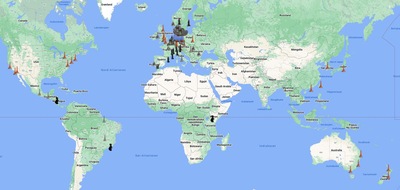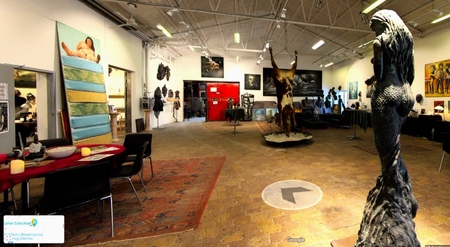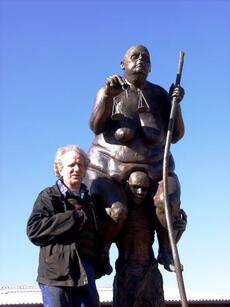|
PRESS RELEASE– October 30, 2025
The Orange Plague - at COP30
A tall Trump sculpture cast in bronze sitting on the back of a fragile man as the King of Injustice, with scales in hand - and a golf-club, is heading for Brazil. Along with 6,000 Mini-Trump-sculptures that are handed out.
Photos right to left:The bronze sculpture 2½meters incl. podium. Original 3D prints, to be handed out at the climate sumit in Brazil. More photos (scroll down)
When world leaders gather for the COP30 climate summit in Belém, Brazil, they will be met by The Orange Plague — a brutal, satirical statement about Trump’s and the United States’ attacks on the green transition and the rules-based world order, and an encouragement to work together to stand against this destructive influence.
The Sculpture
Including podium the copper sculpture stands 2,5 meters tall, portraying a corpulent, nude Trump perched arrogantly on a thin young man in sneakers and shorts — an image of power imbalance and denial. In one hand Trump holds a golf club, in the other a scale of justice. Next to him, a golf ball shaped like Planet Earth lies on the ground.
On the pedestal is engraved the haunting inscription:
I am sitting on the back of a man.
He is sinking under my burden.
I will do anything to help him.
Except stepping down from his back.
Inspired by “The Emperor’s New Clothes” – with a Golf Club Twist
Artist Jens Galschiøt describes the work as a modern version of “The Emperor’s New Clothes” by Hans Christian Andersen, in which a vain ruler parades naked, believing himself dressed in the finest garments. The illusion — sustained by fear and flattery — endures until a child cries out, “He’s not wearing any clothes” - and the emperor becomes a figure of ridicule.
“Trump is the naked emperor, trapped in his own illusion of greatness. Everyone can see the truth — but few dare to say it aloud,” says the Artist Jens Galschiøt.
Using grotesque humor and theatrical exaggeration, the sculpture draws from the traditions of political satire and commedia dell’arte, where laughter is used as a weapon against fear and power. “Laughter disarms tyrants. Once the laughter begins, the fear disappears — and power stands naked,” Galschiøt adds.
To amplify the message, Galschiøt and his team have produced 6,000 miniature 3D-printed copies of the sculpture that will be handed out freely to delegates and activists at the summit. Each tiny Trump bears the engraving King of Injustice and The Orange Plague, along with the text I sit on the back of a man, I will do anything to help him, Except stepping down. See 3D printing in progress
The miniatures are part of a street-art-style action. Each small figure acts as a “sculptural outcry”, a visual protest symbol meant to spark debate and viral attention. All 3D print files for the mini-sculpture are released freely under open license. Anyone can download and print their own version of “The Orange Plague”. Get Print Files
The purpose of the project and why Donald Trump?
Trump is undermining the climate efforts, rolling back hard-won progress, and even destroying the scientific data that documents it. Worse yet, he is using power and economic pressure to discourage other nations from pursuing green initiatives — thereby weakening the global fight against climate change.
Nations as well as NGOs are afraid to openly raise the subject on how to deal with Trump and his policies, fearing tariffs, fund-cuts, deportations or the like. As an independent art workshop we are not restricted by such bonds. This sculpture has been made to address "the elephant in the room" and start a necessary debate of how the US is destroying the world’s only chance to counter the climate catastrophe and a debate on how to stand up against him.
Participation and Collaboration
The project “The Orange Plague” is open for collaboration with NGOs, artists, and COP30 participants.
Organizations and individuals are invited to take part by:
For coordination please contact: aidoh@aidoh.dk - whatsapp +45 61703083
Galschiøt Returns to Belém – 25 Years After His “Pillar of Shame”
This is not Galschiøt’s first major intervention in Brazil. Back in 2000, Galschiøt erected a Pillar of Shame-sculpture in Belém in collaboration with Brazil’s current president Lula da Silva and the land rights movement MST, as a commemoration of the Eldorado-massacre in which 19 landless peasants were killed by military Police.
The sculpture still stands in Belém today as a powerful symbol of resistance. The Pillar of Shames are erected around the world as a kind of "Nobel Price" for Crimes Against Humanity. Another one is the world-famous Orange Pillar of Shame in Hong Kong. Scroll down to learn more about this.
Pillar of Shame in general (Wikipedia) Pillar of Shame in Brazil Galschiøt is no stranger to using art as confrontation. His monumental installations have appeared at COP15 (Copenhagen), RIO+20, COP21 (Paris), COP23 (Bonn) and COP29 (Baku) — often becoming media icons and protest symbols at the summits.
Contact
Links:
 A short self-introduction by Jens Galschiøt
I am a Danish artist who has exhibited climate related art at climate conferences all over the world, including COP15, RIO+20, COP21, COP23 and COP29, often with support from the Danish government. In my experience, art can serve as a powerful complement to the many words exchanged at a climate summit. My sculptures are often used by the media as sort of mascots for the events. They are easy to understand visual expressions of the climate issue and what is at stake at the conferences.
COP30 - An Art Work Says More Than a 1,000 Words
|
||
|
||
|
******************************************
******************************************
Subscrition and unsubscription of informations from Jens Galschiøt
If you want to be unsubscribed from this infolist, then click here: Unsubscribe
If you want to update your name, e-mail etc. on this list, click here: Change Profile
If you want to subscribe this infolist, then click here: Subscribe to Galschiøts infoliste
|









